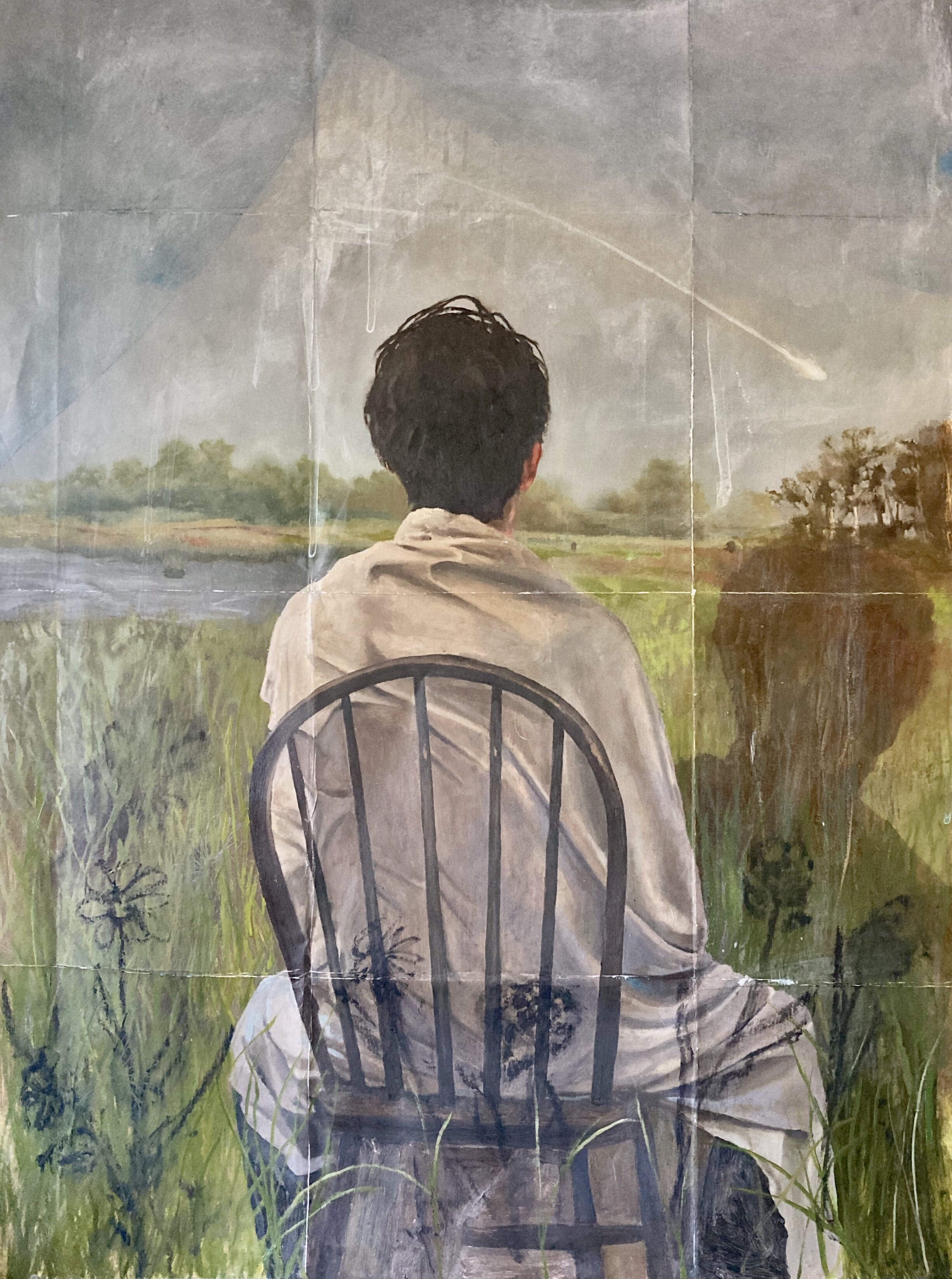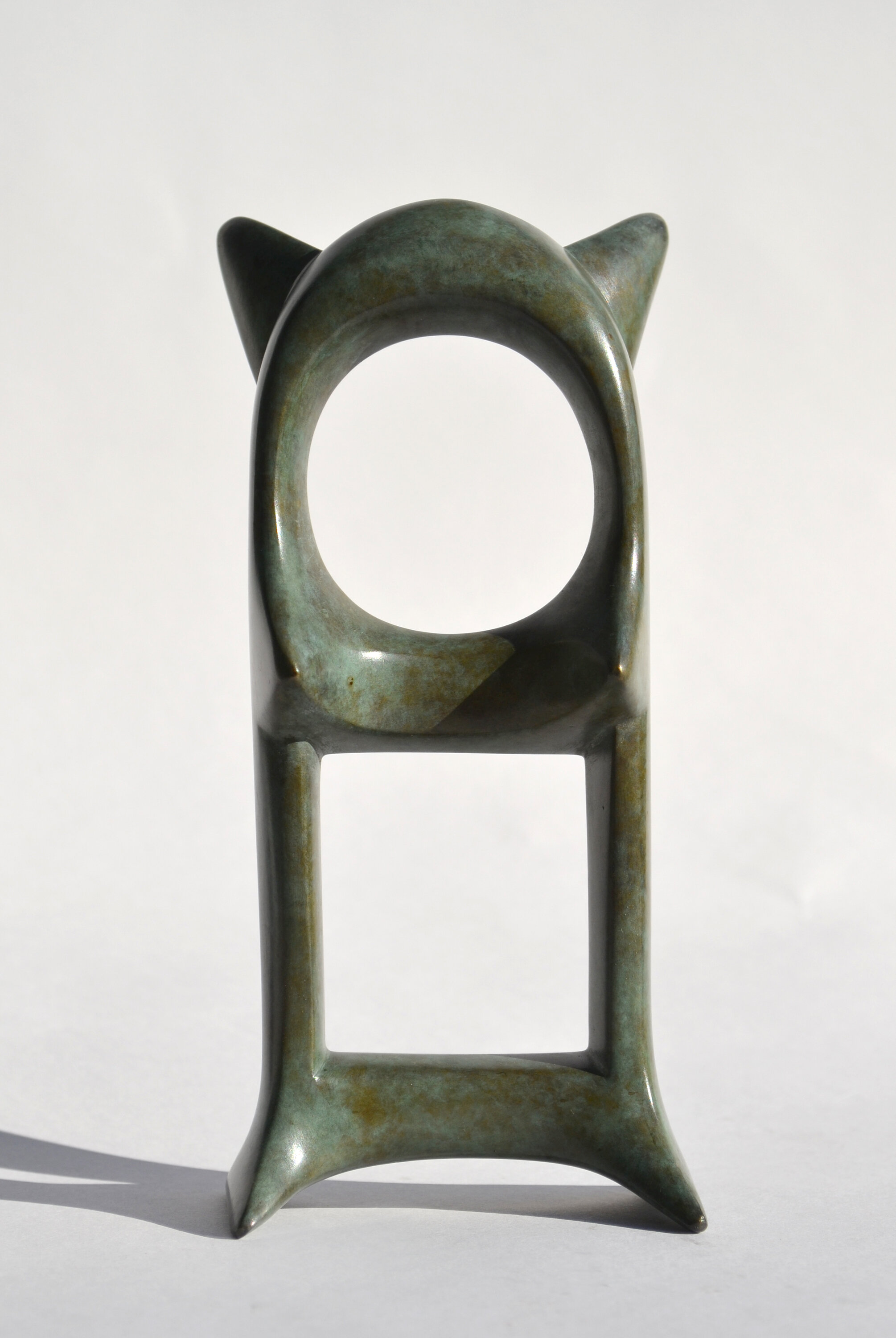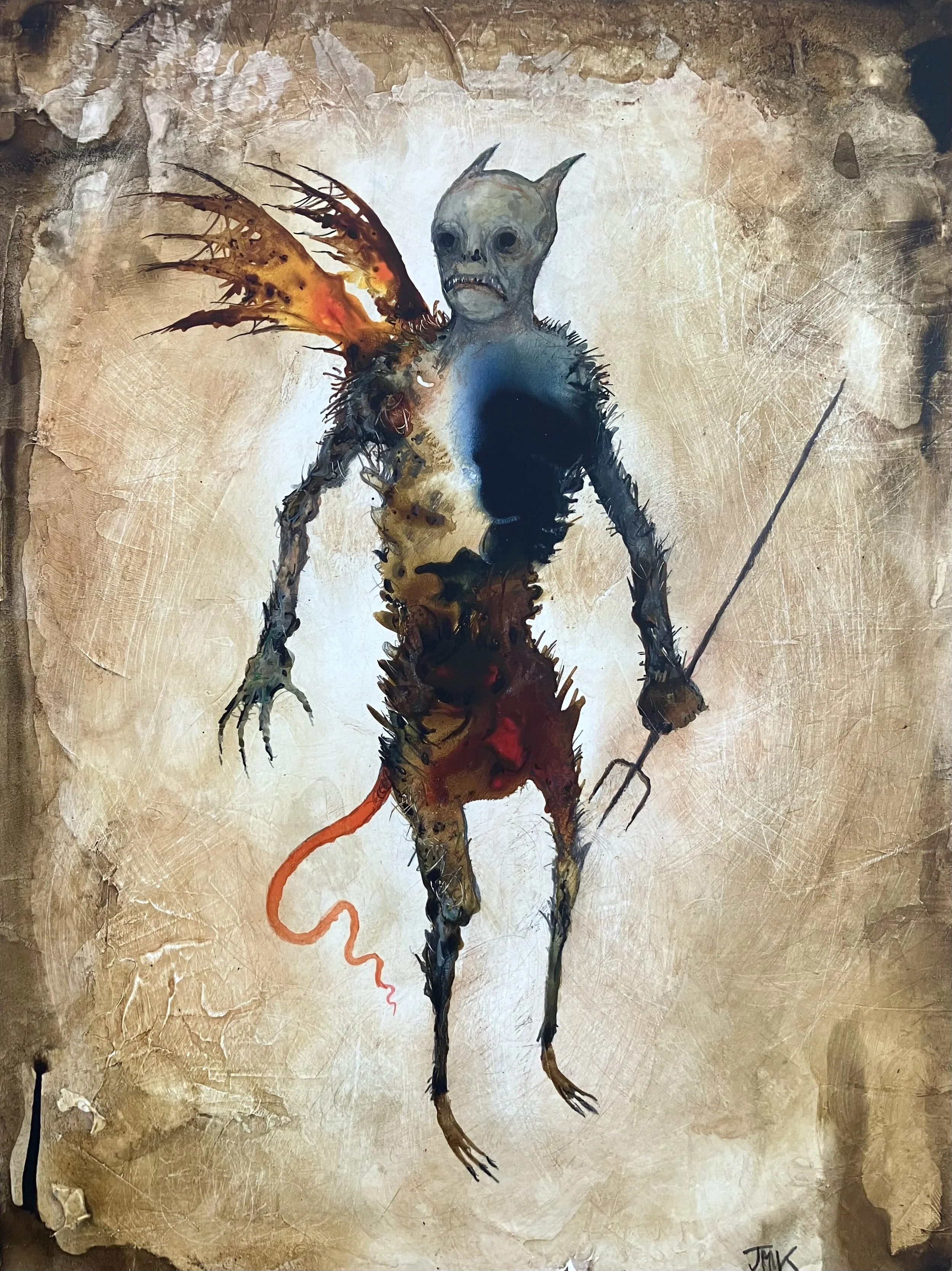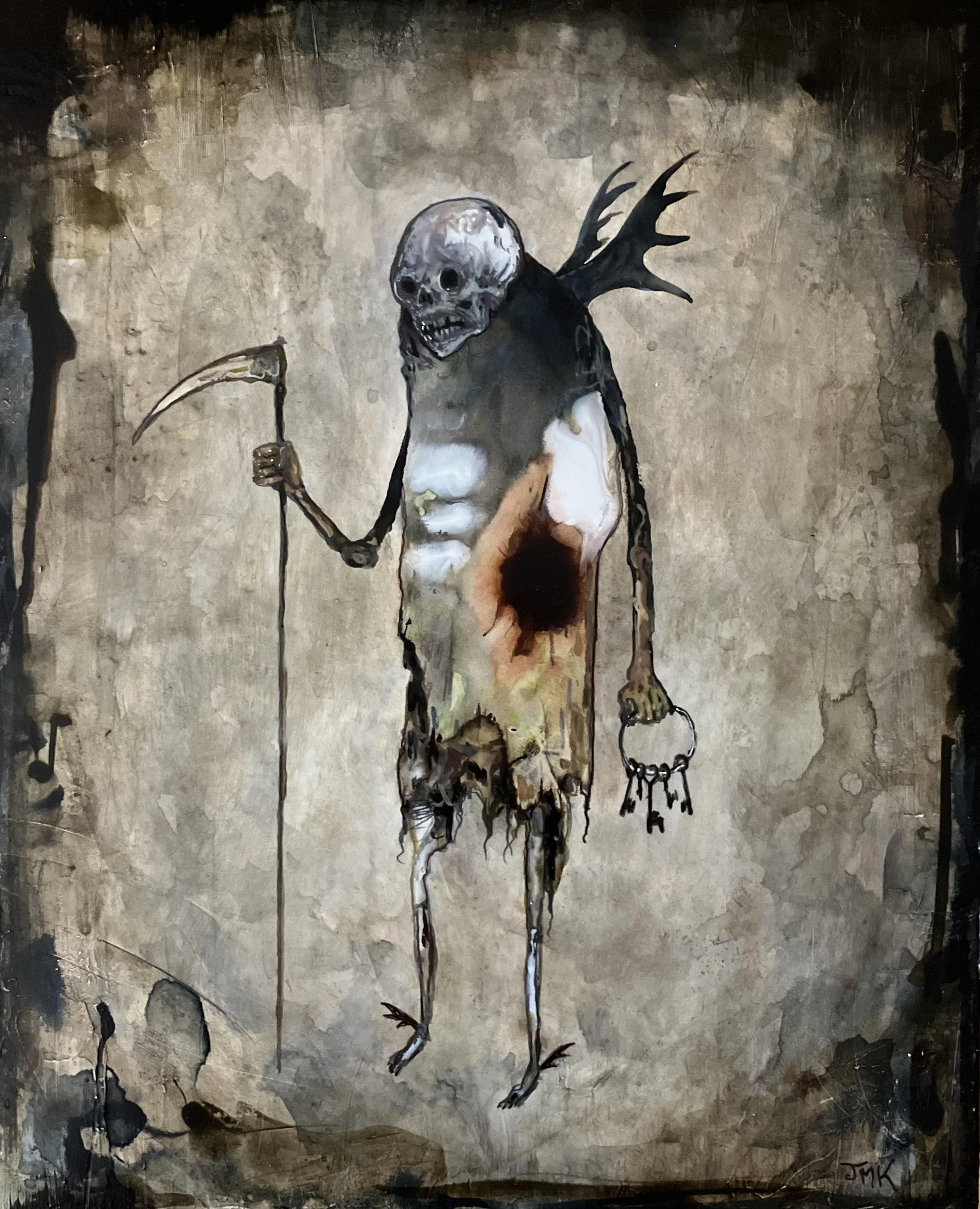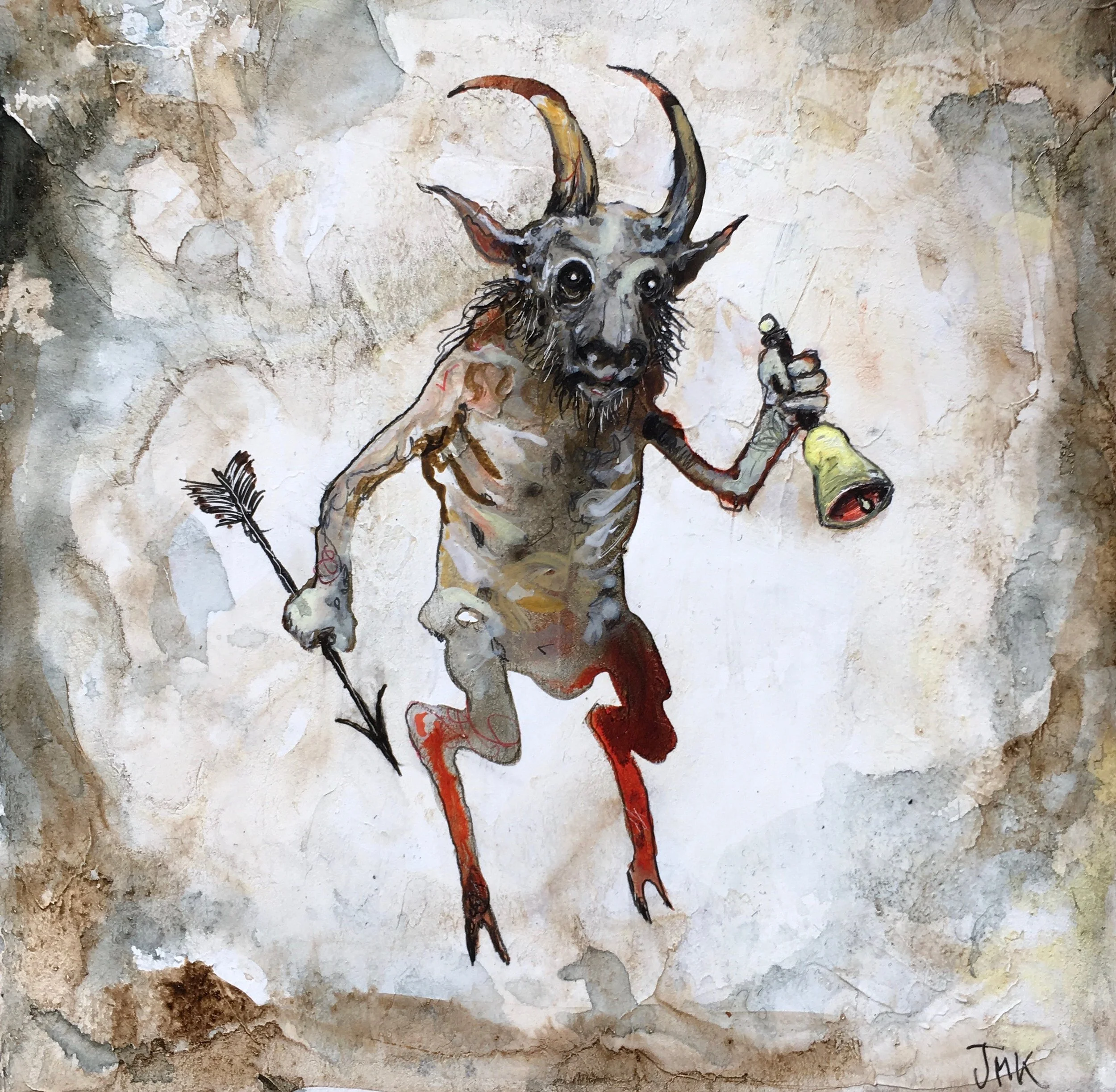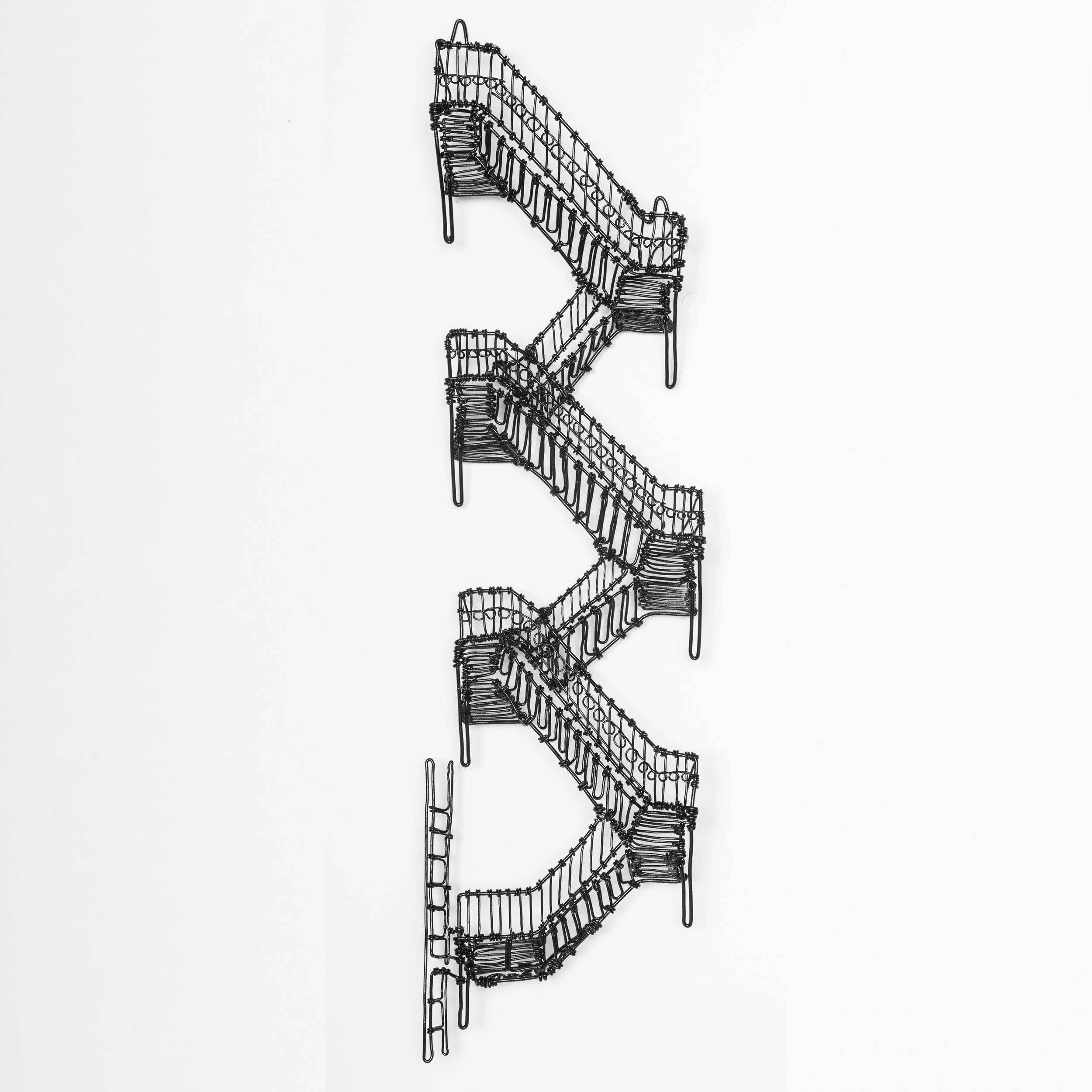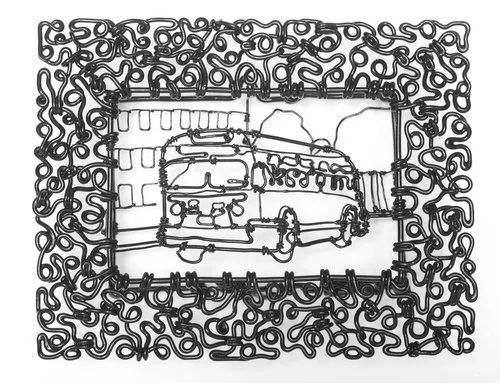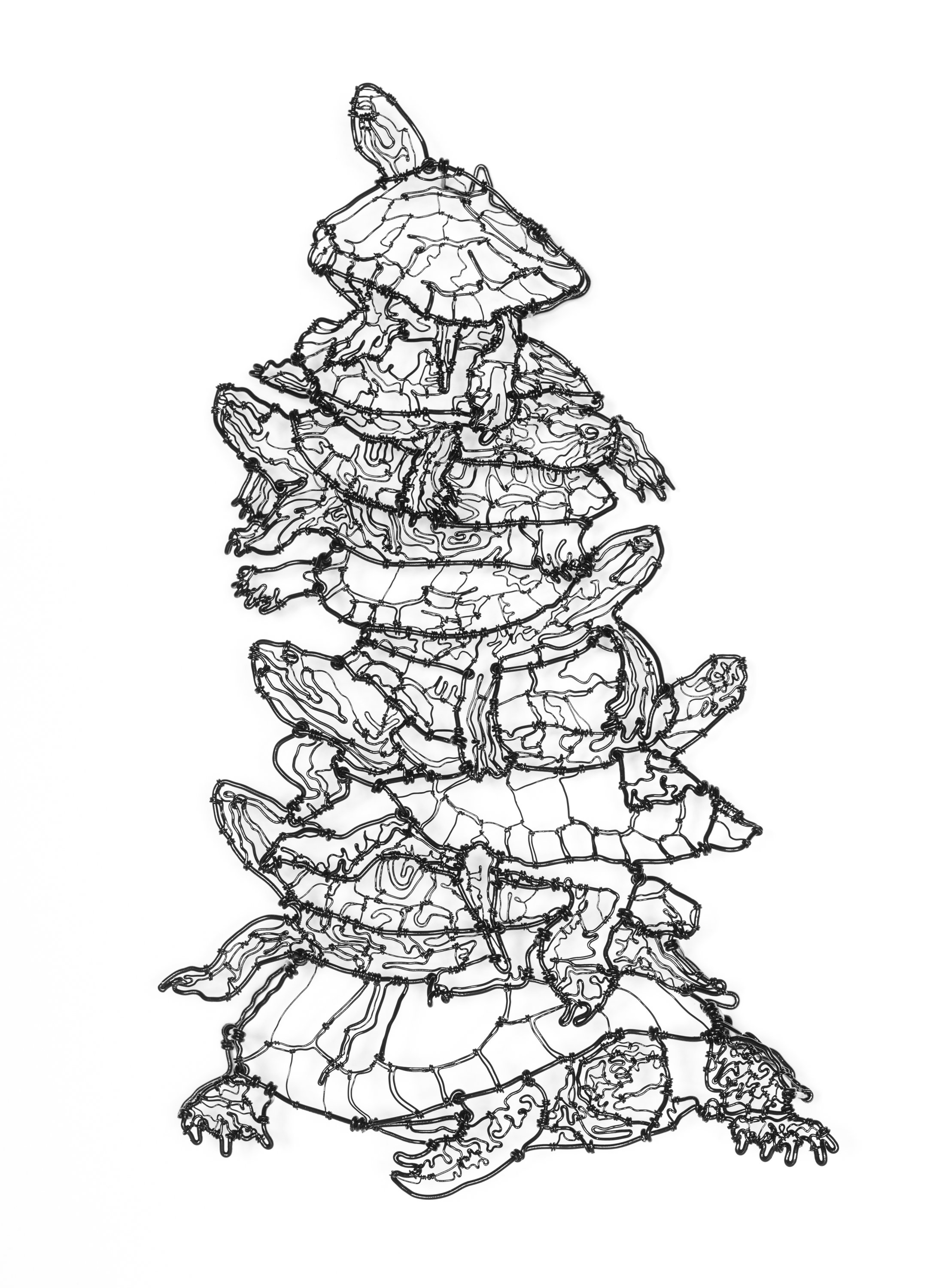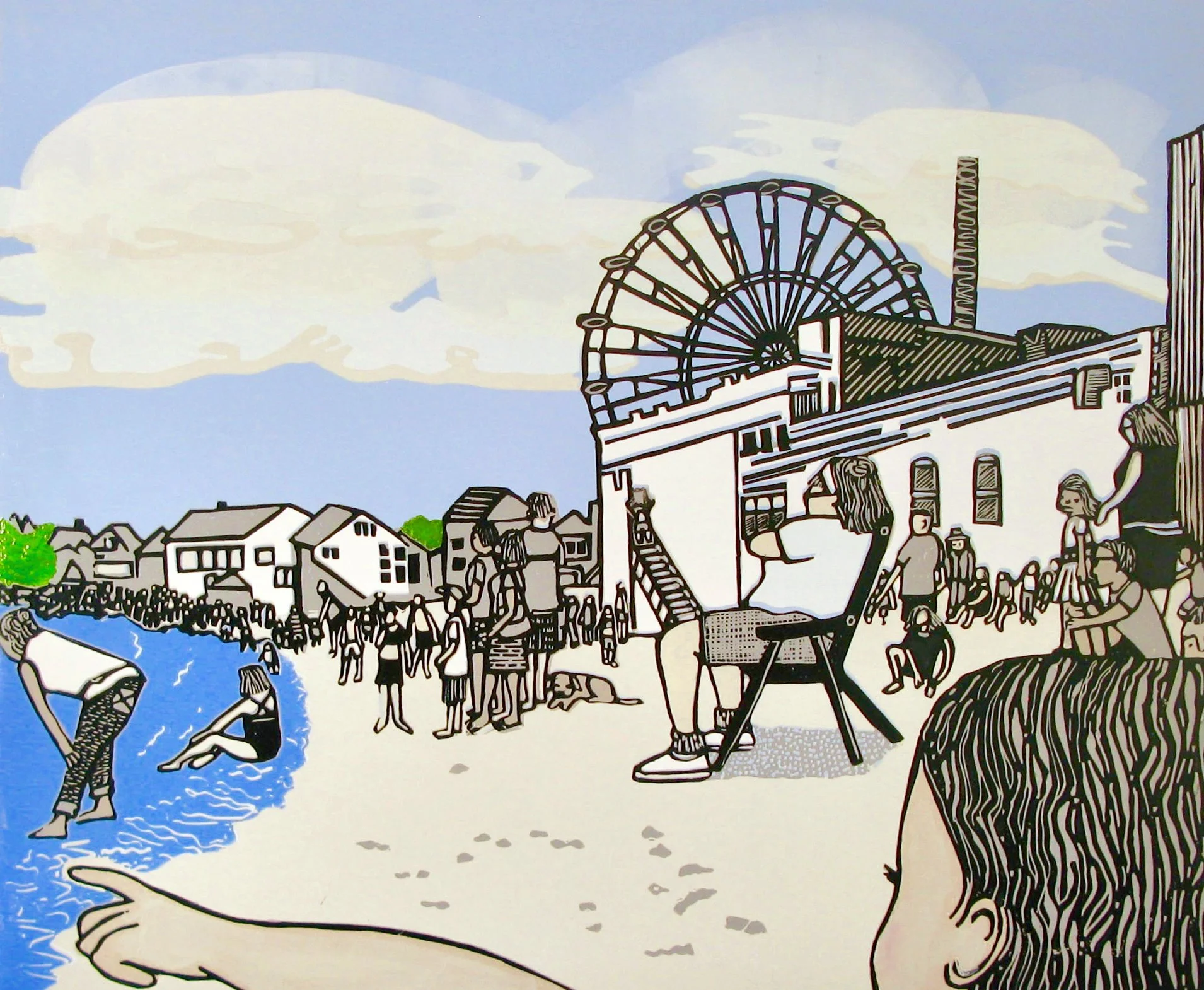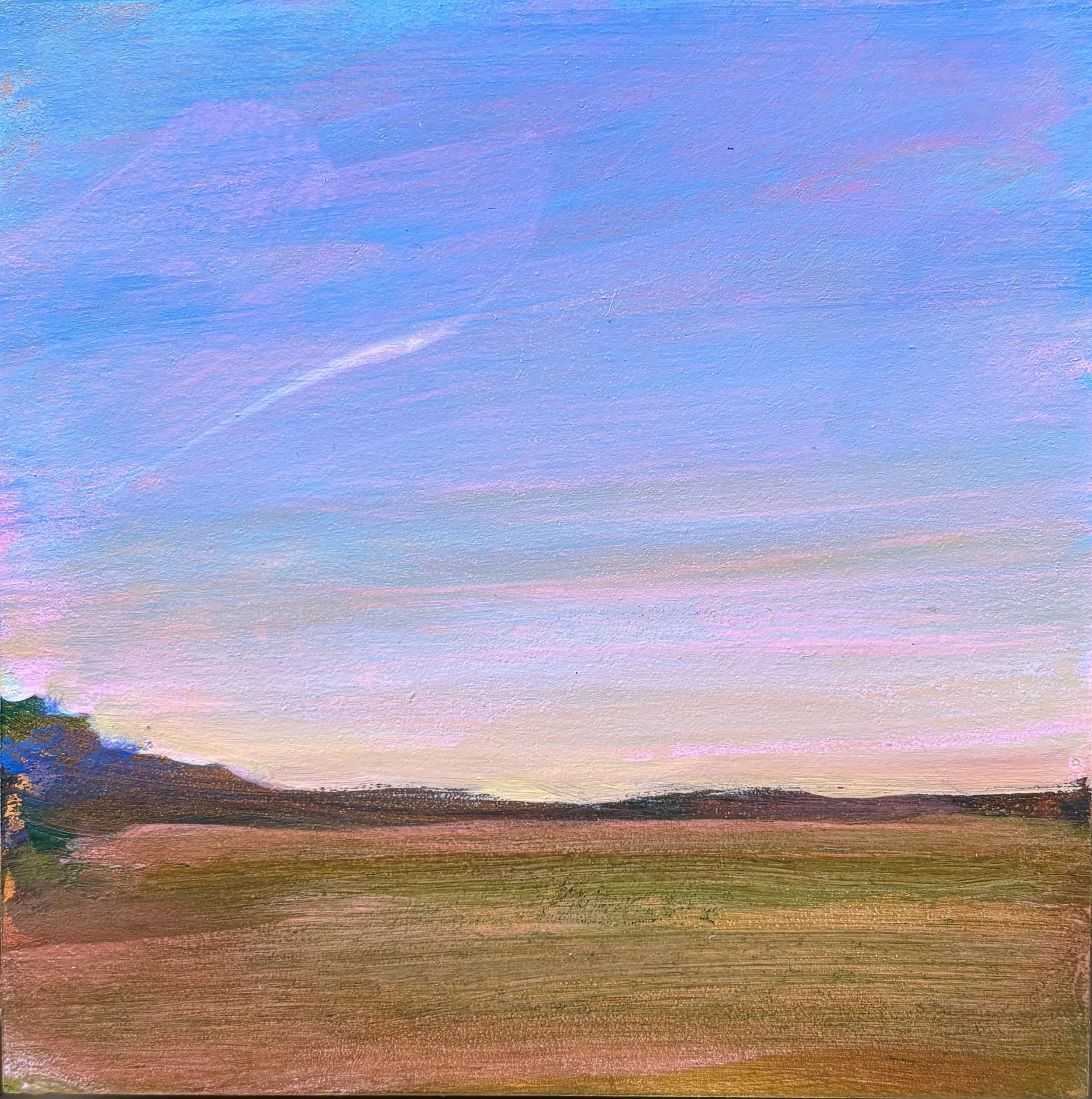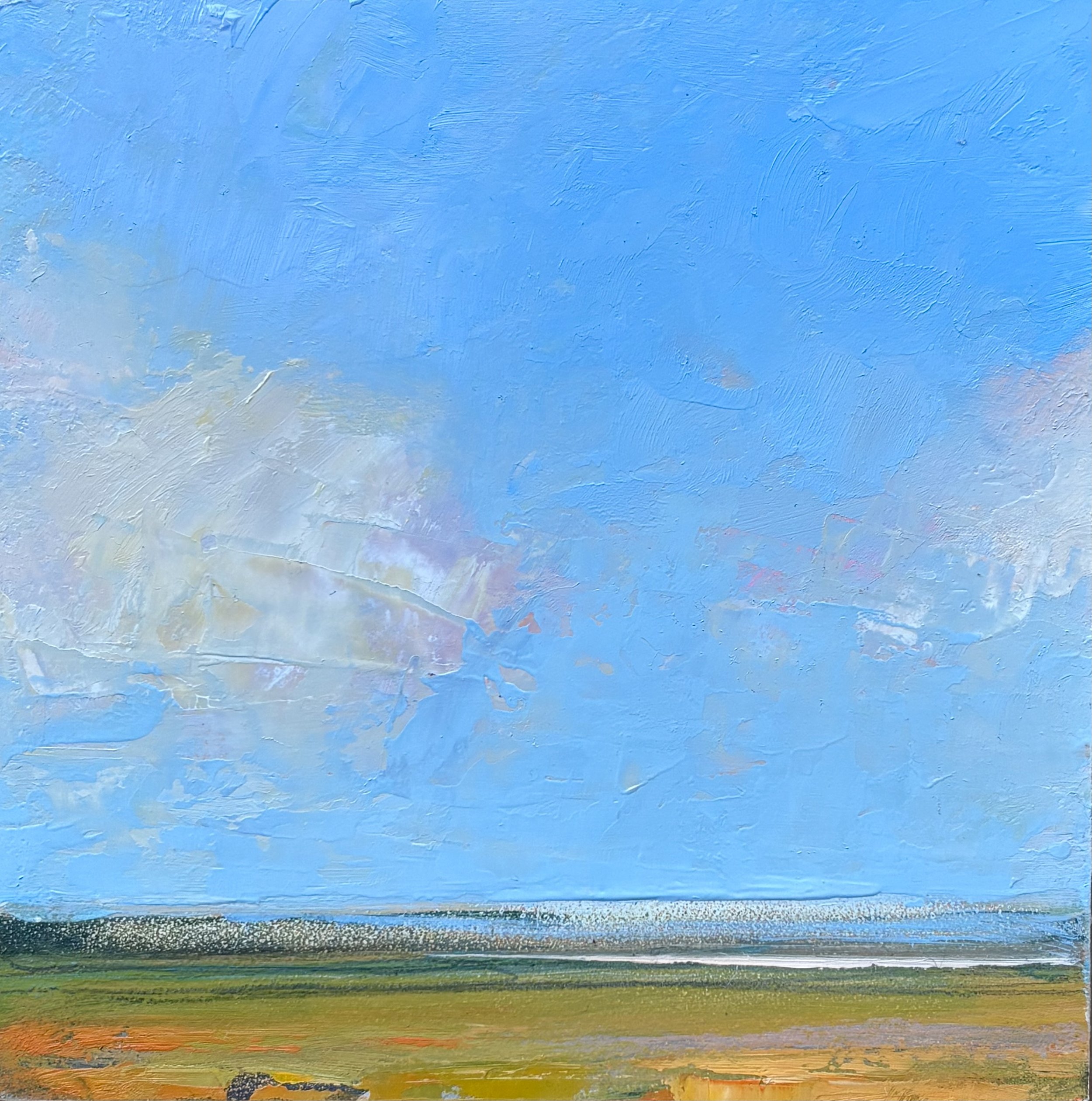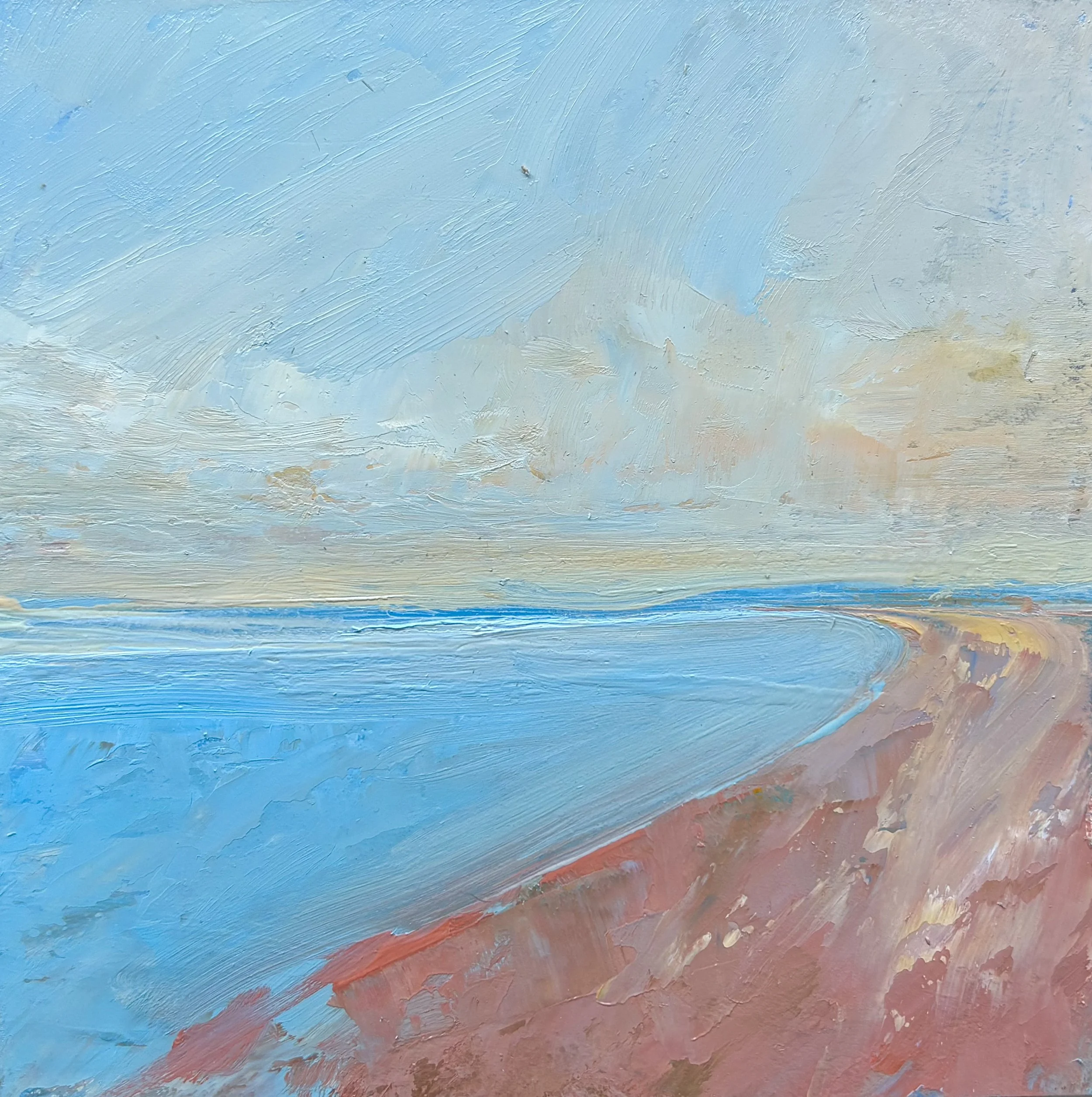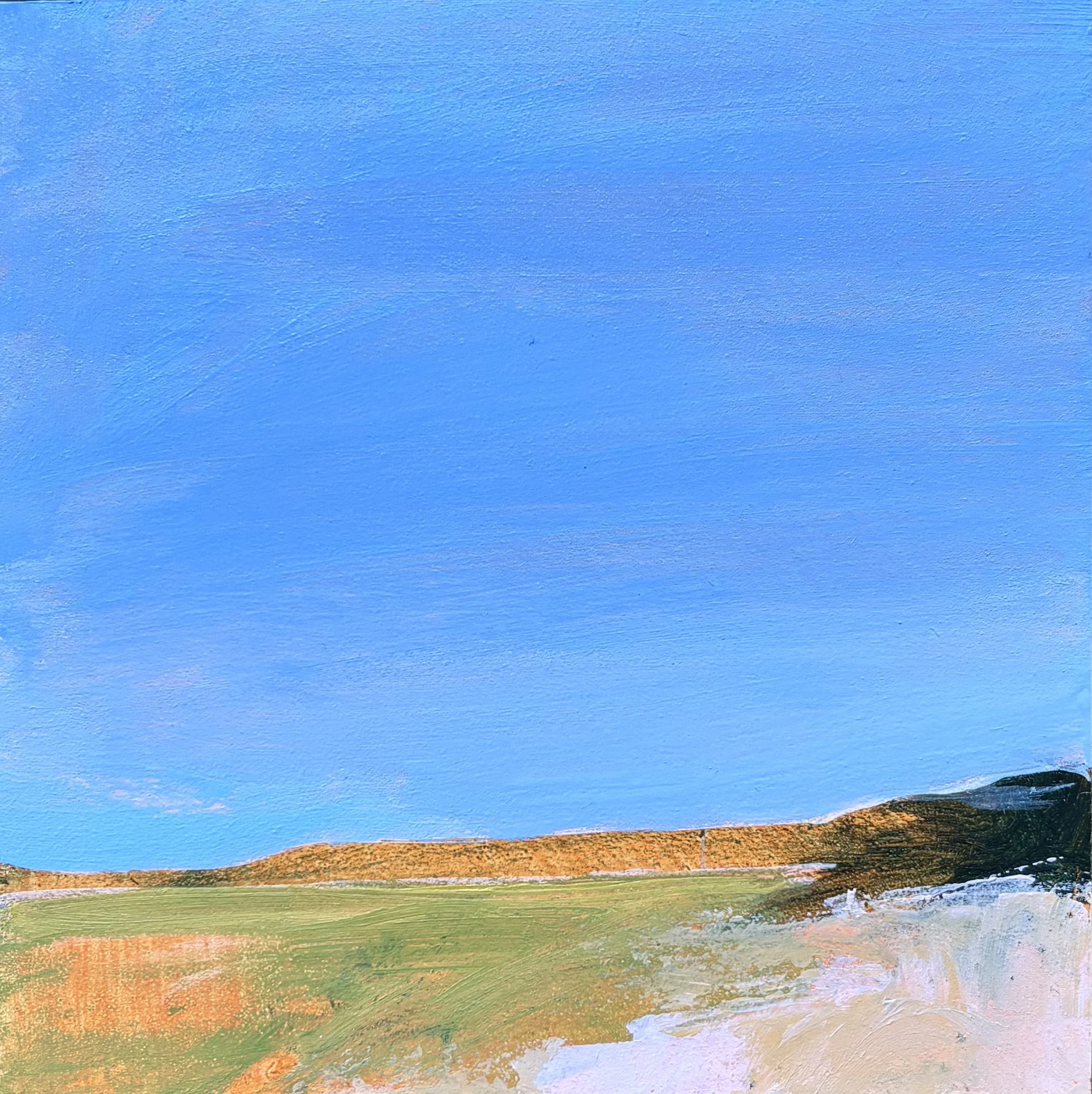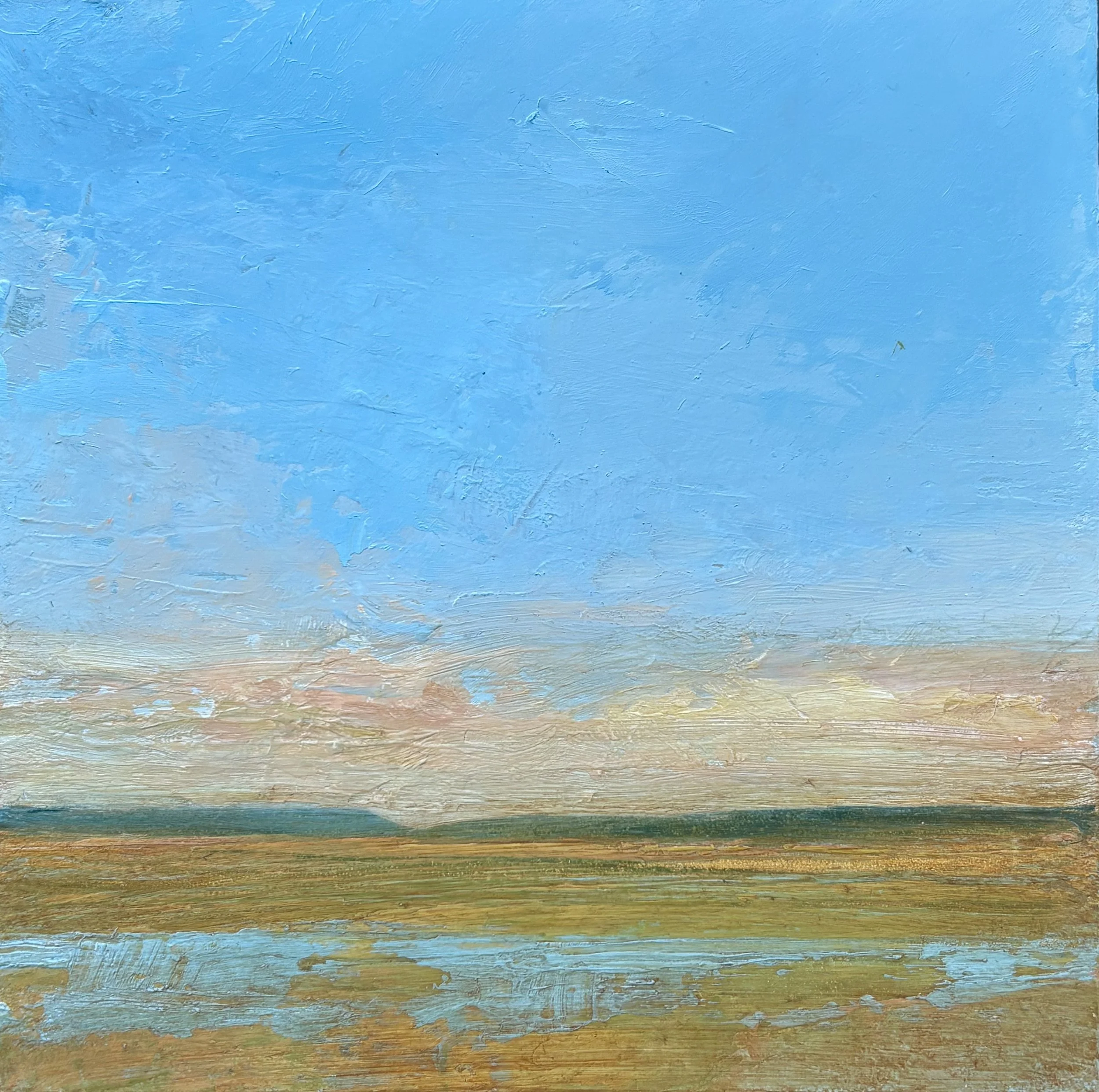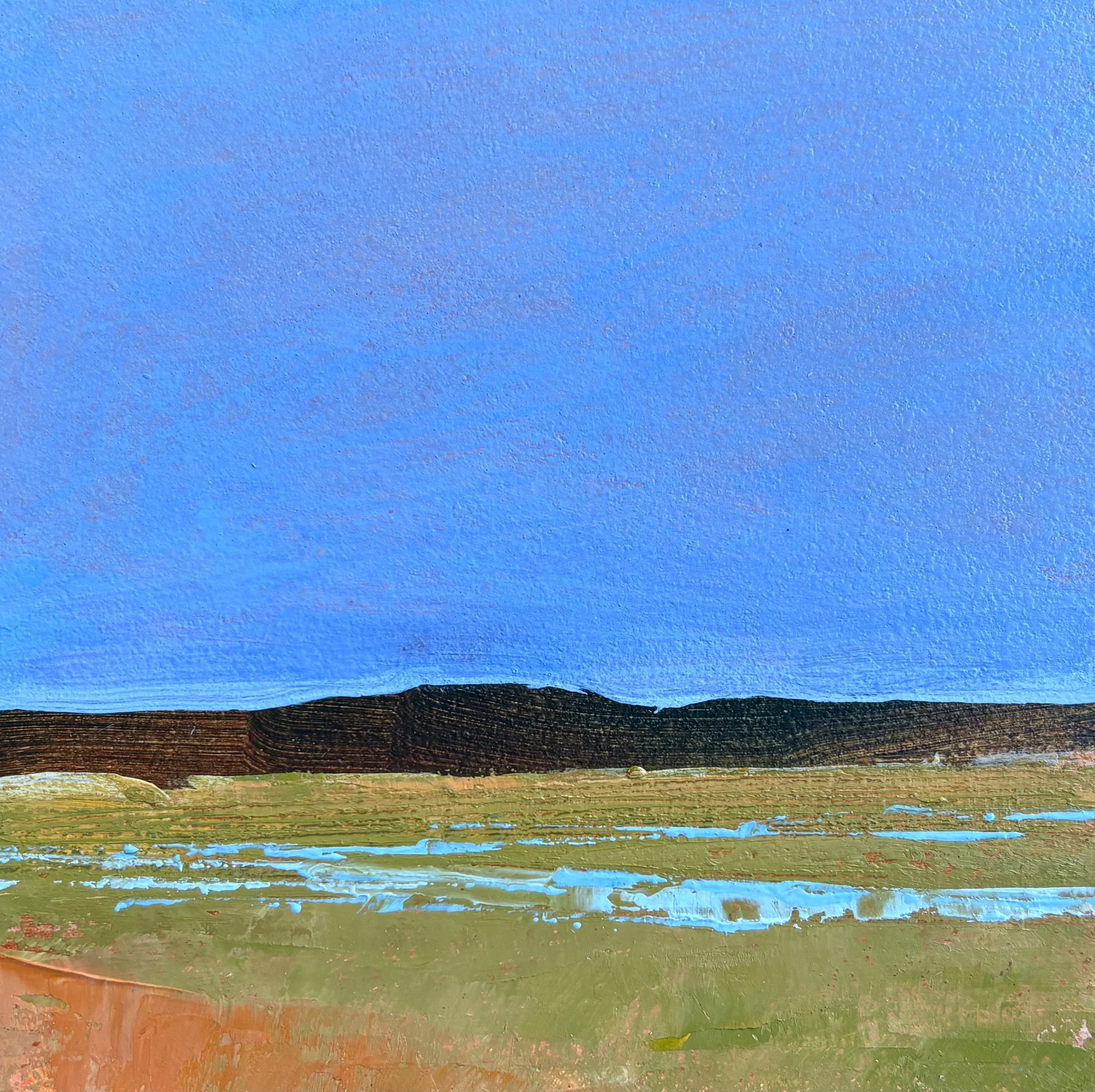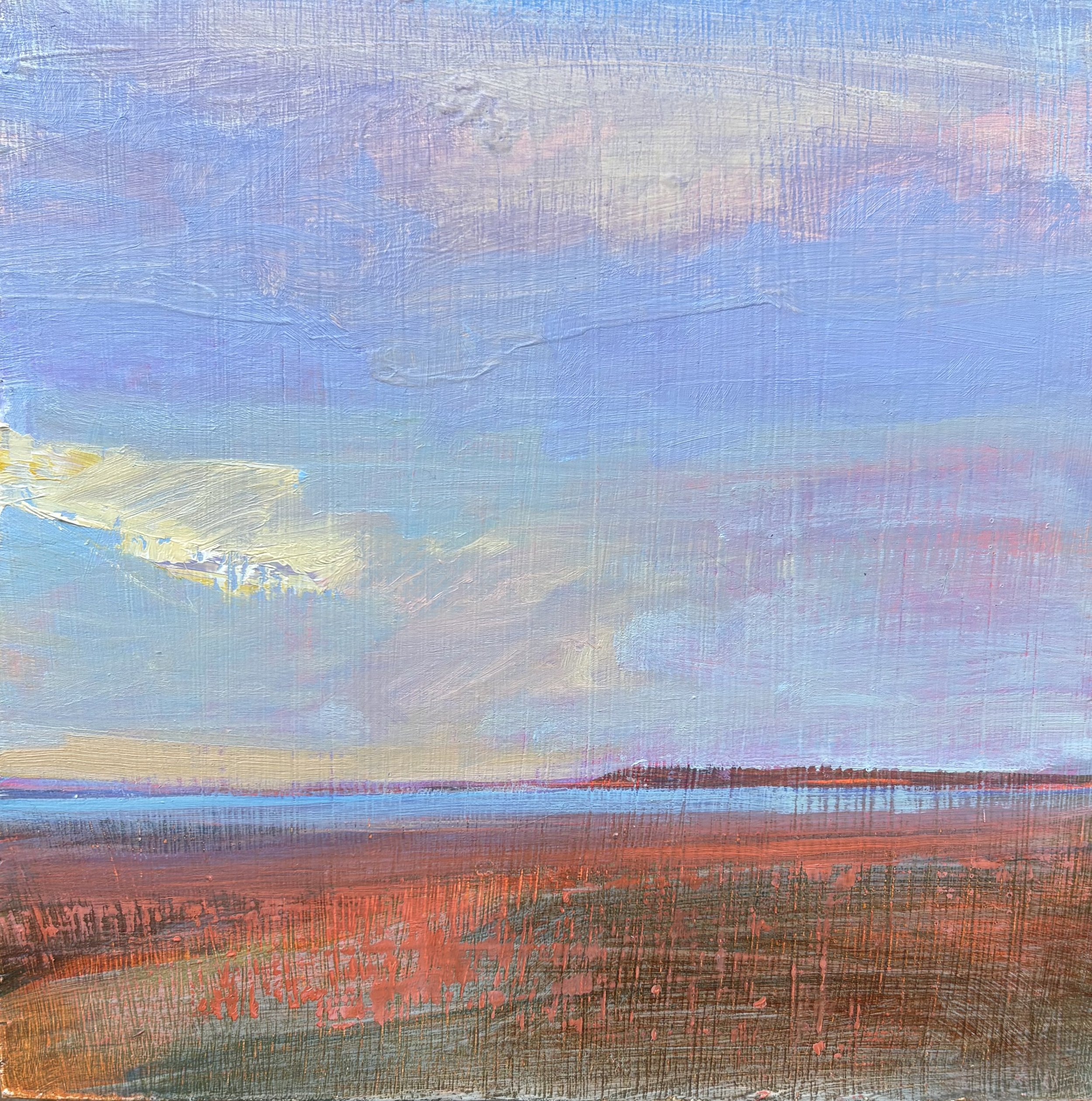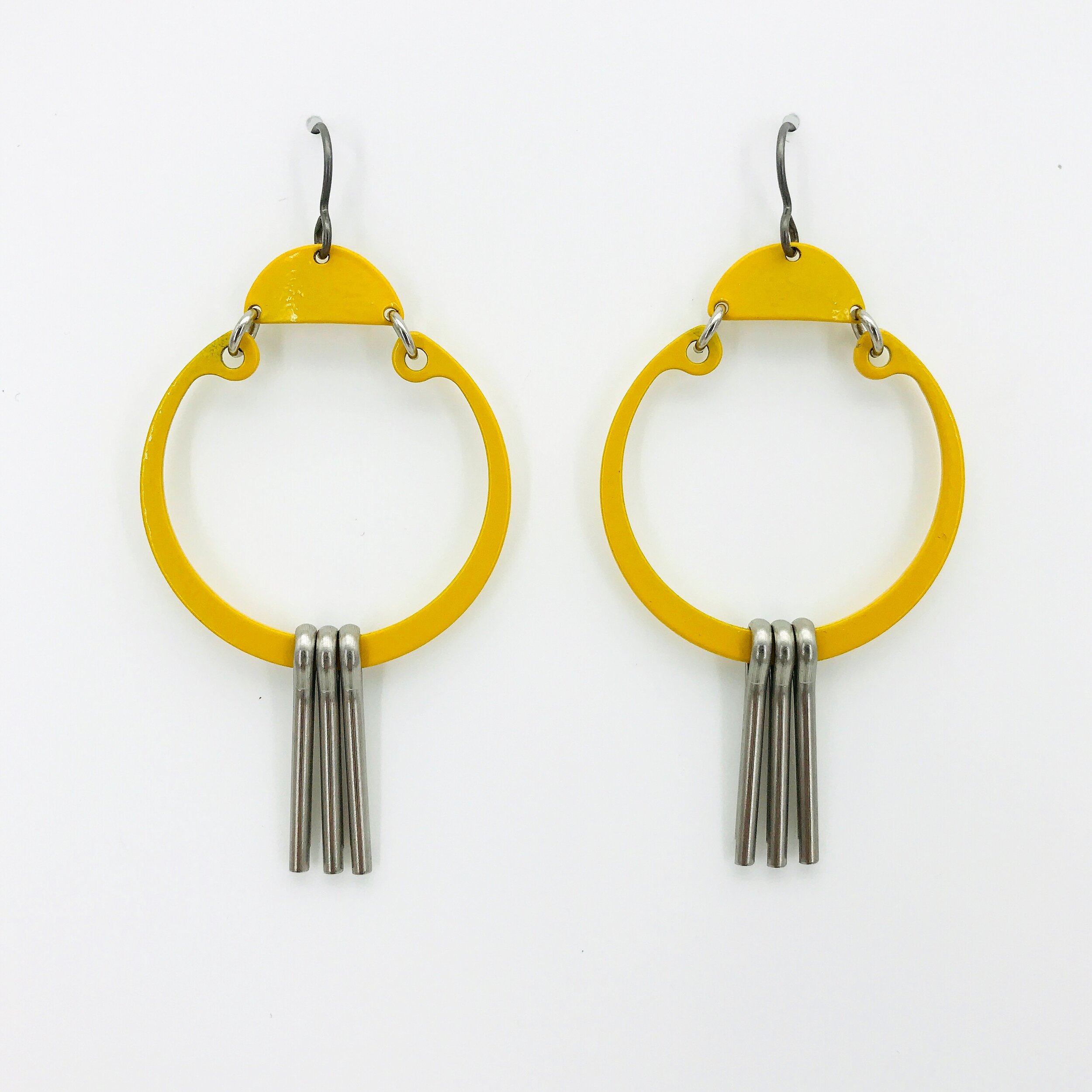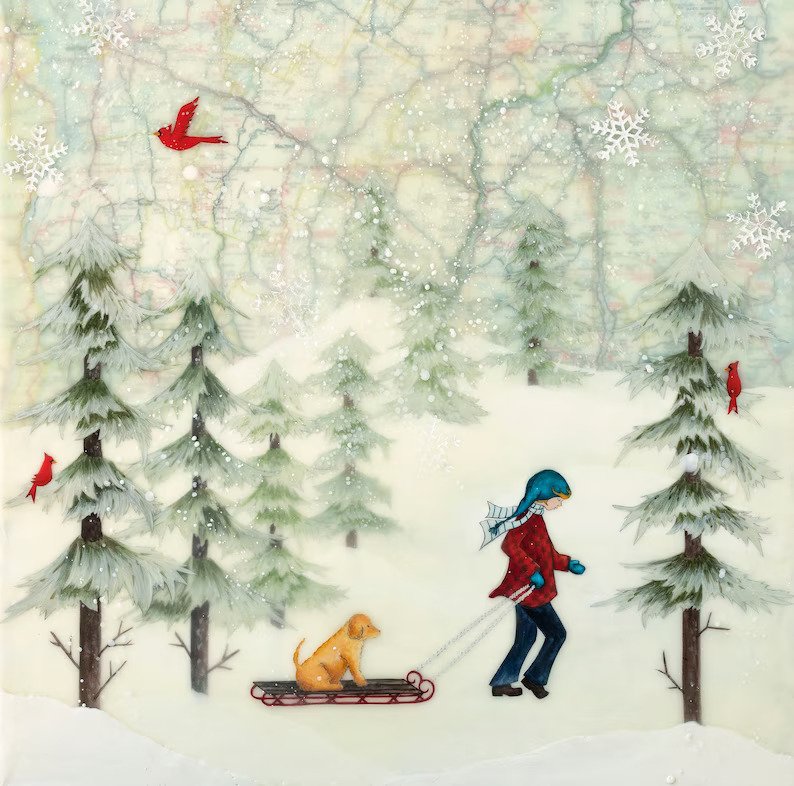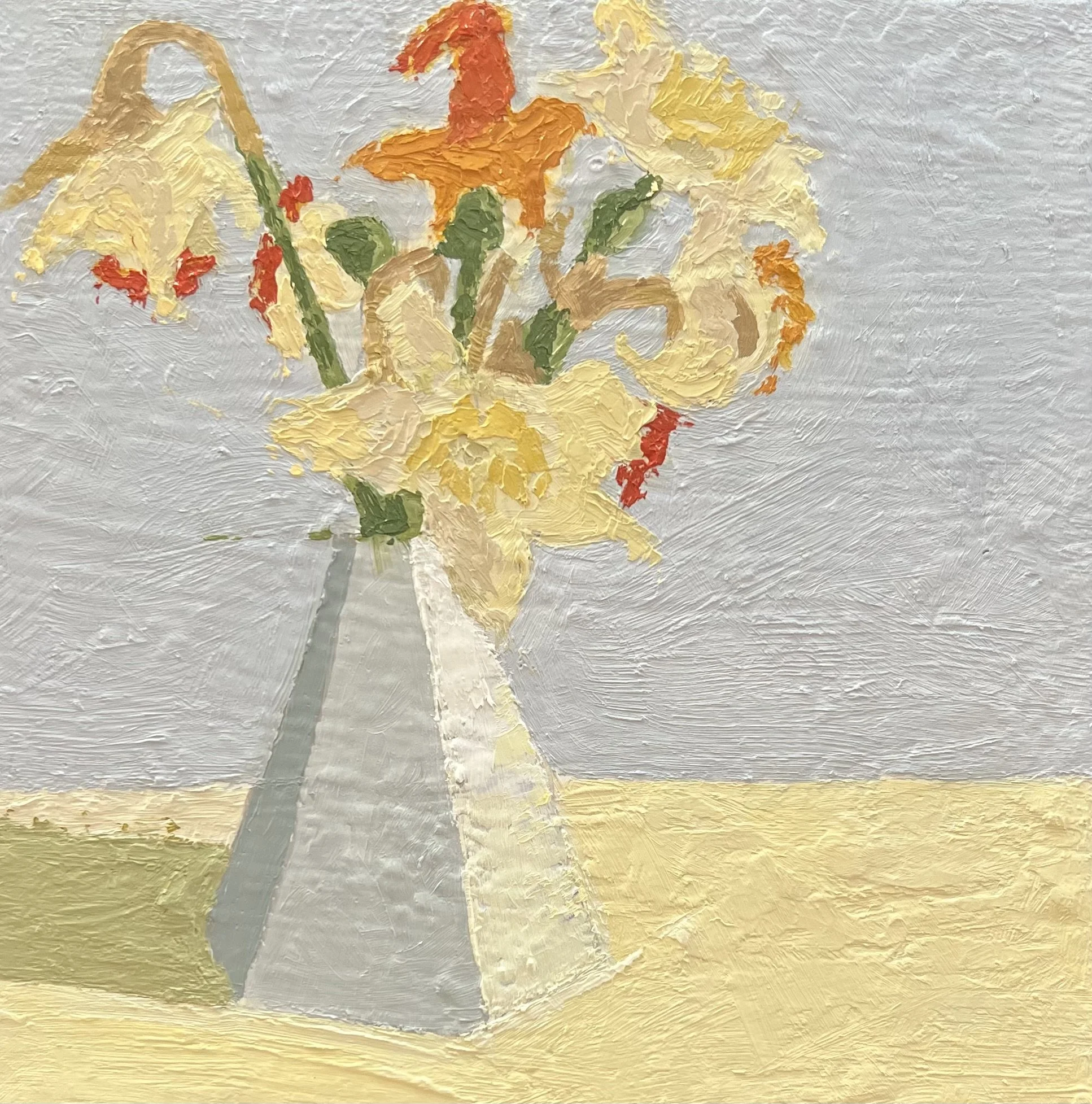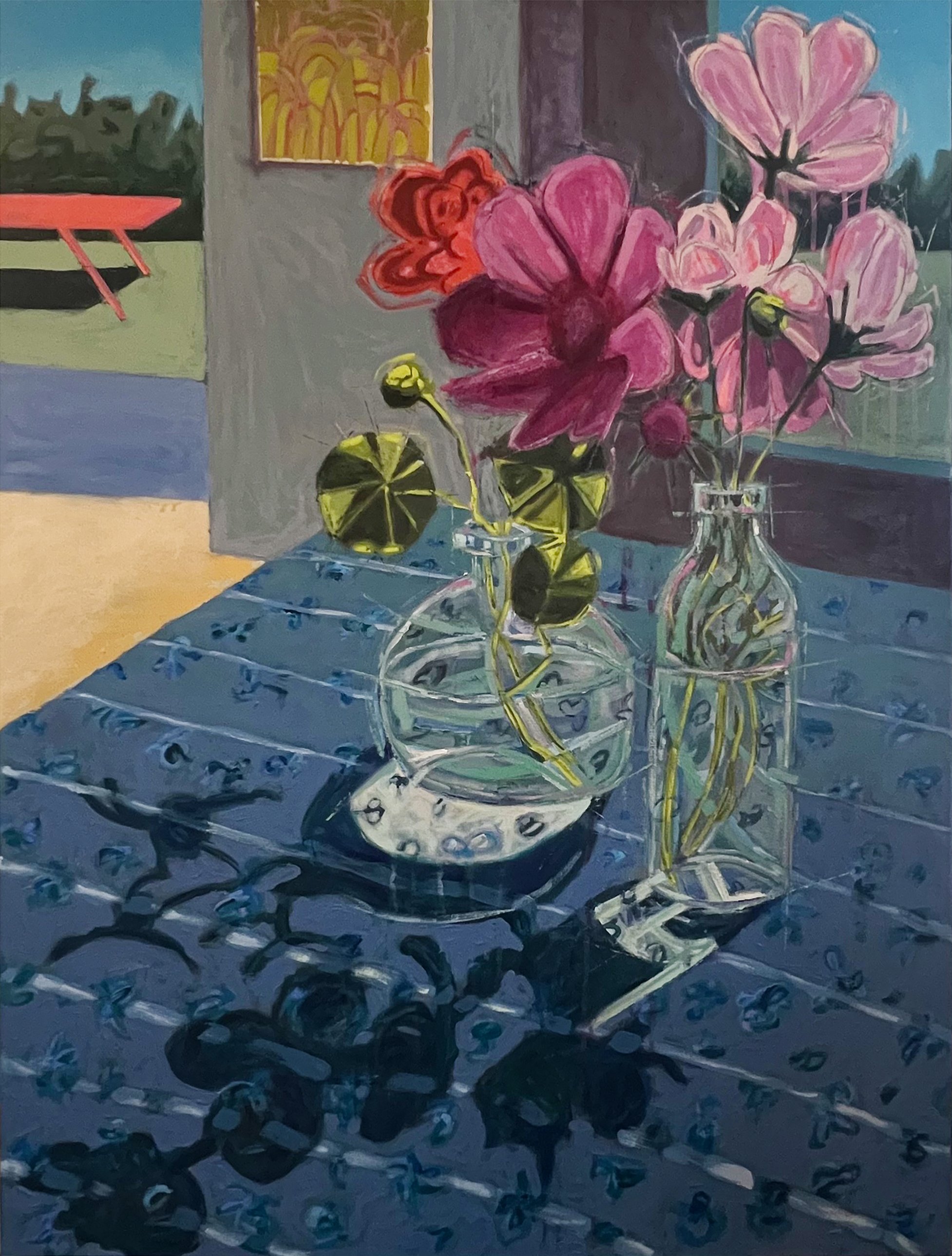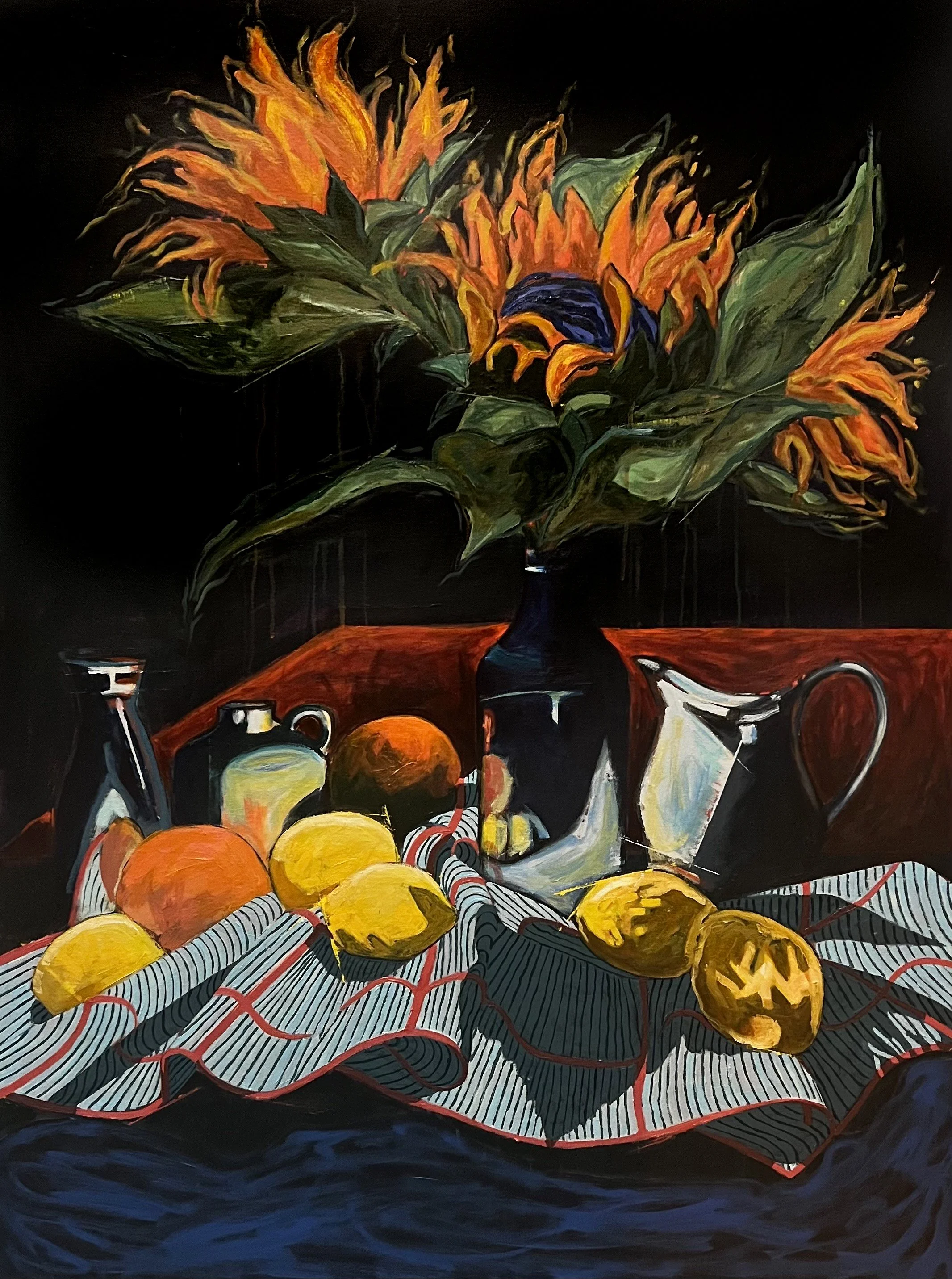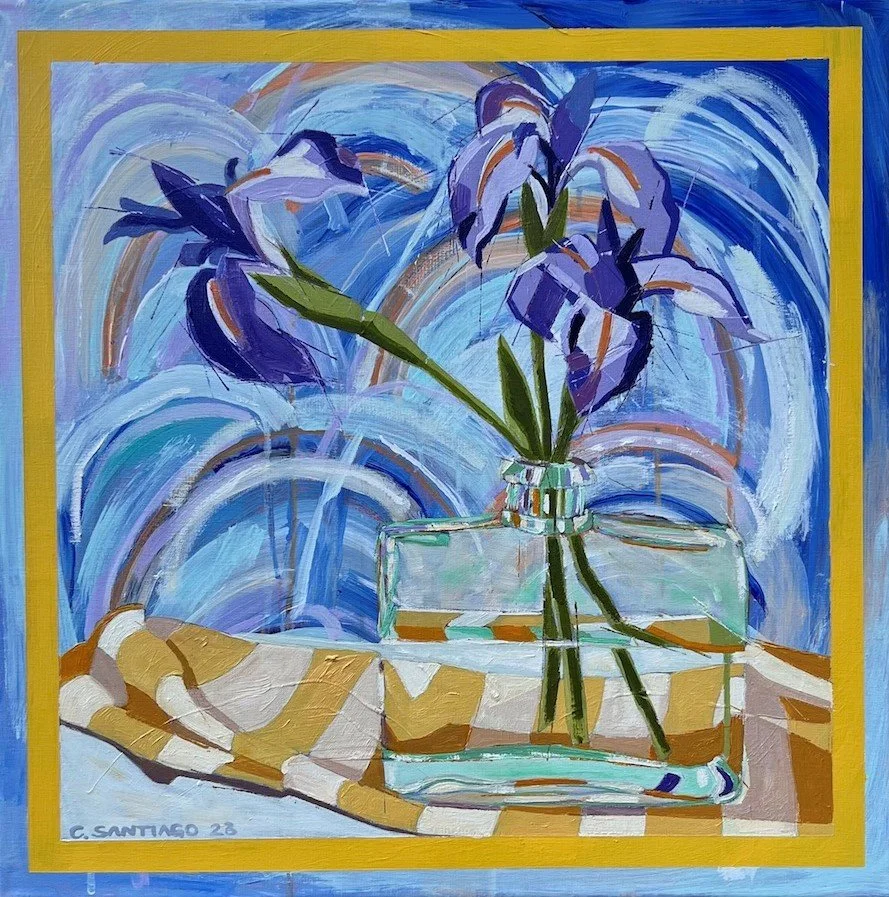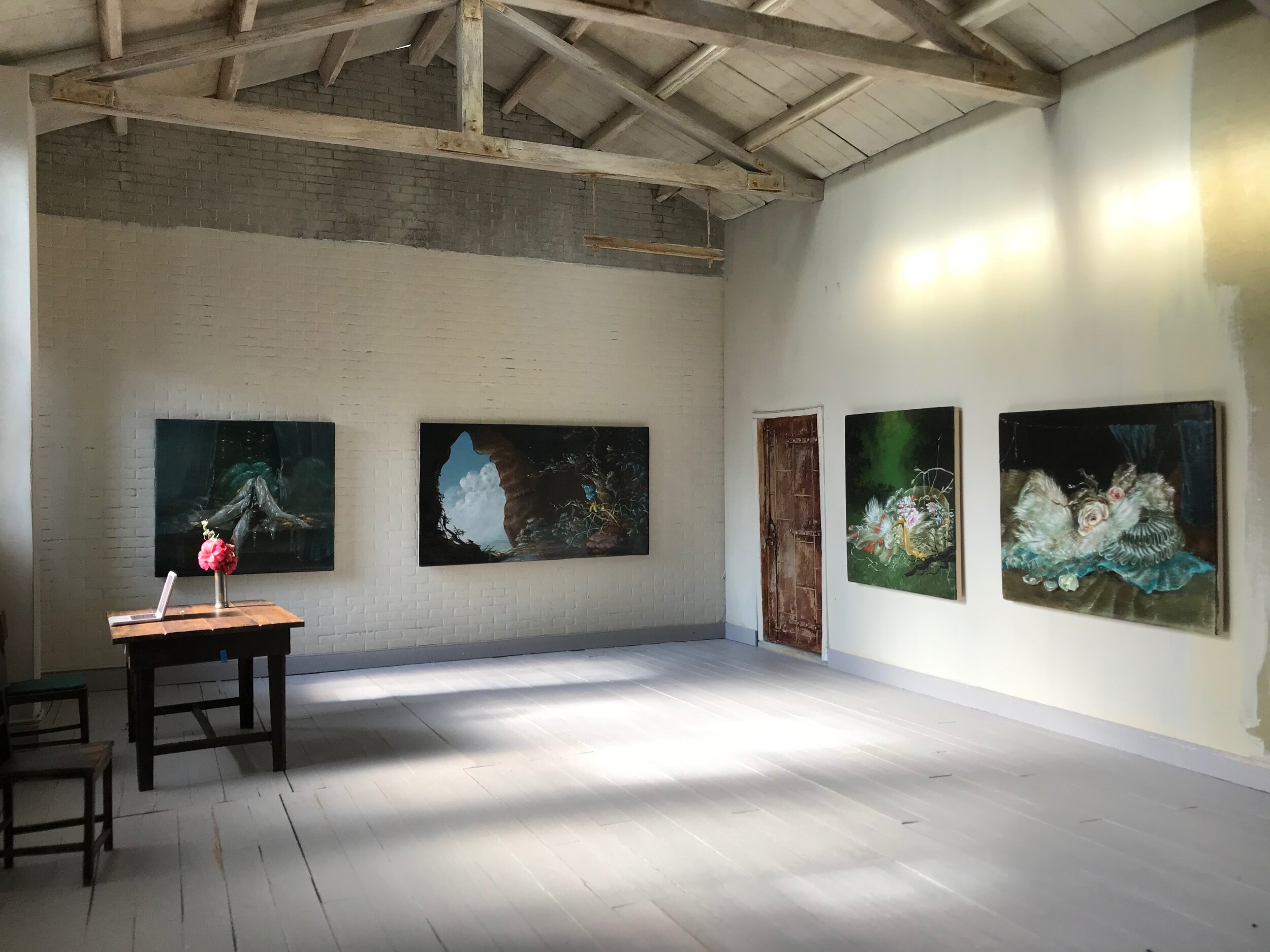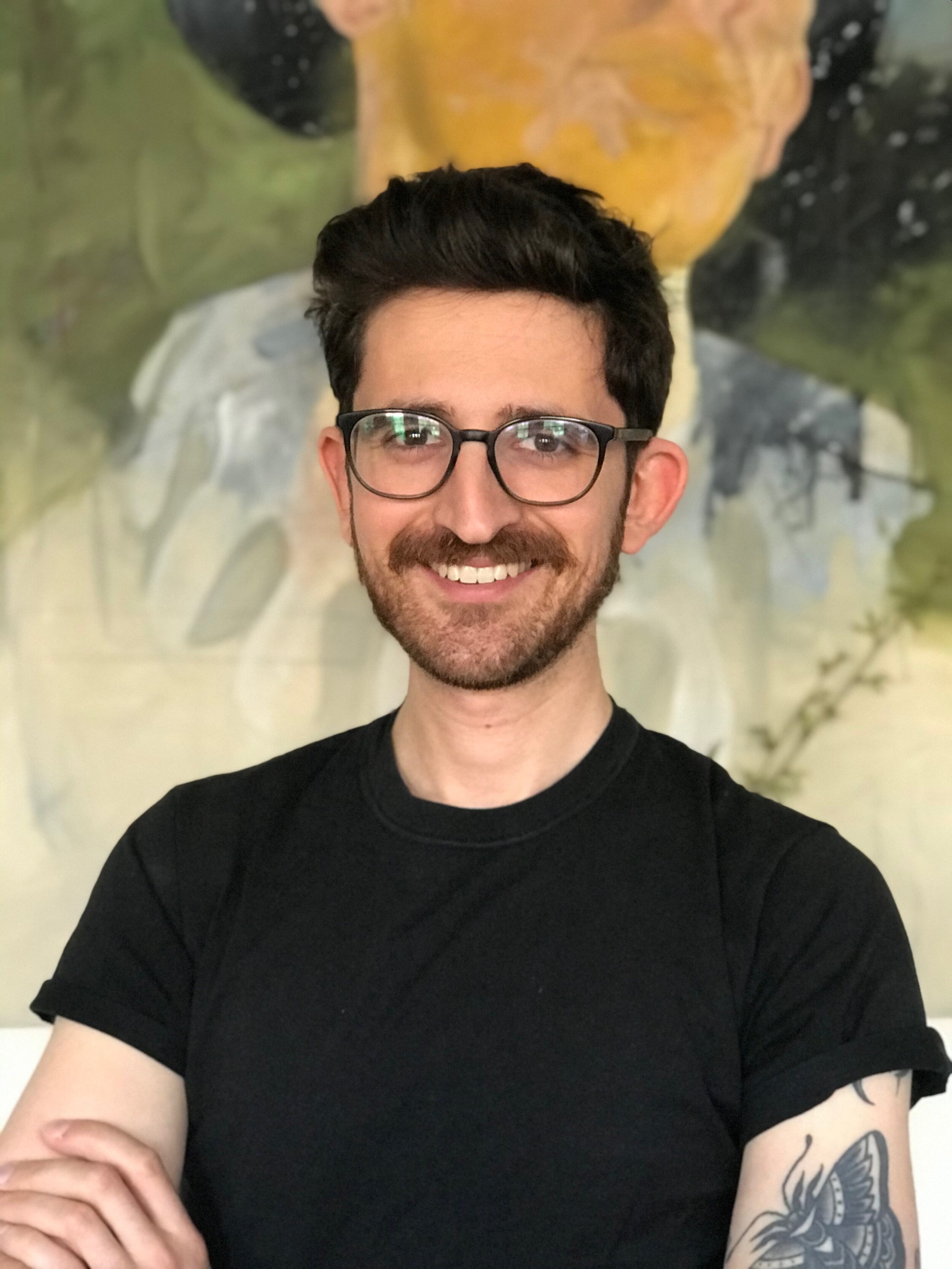The following is an interview conducted by gallery co-owner Jim Kiely and artist Dorothea Van Camp in early 2019 reflecting on, among other things, the trajectory of her career from painting to printmaking.
Light, gravity and hardly an object to be found. That was the first mental note I made while visiting Dorothea Van Camp’s studio and paging through a portfolio that spanned two decades. On the surrounding walls were paintings and dozens of freshly dry prints, which brought the portfolio current to the day. In a half hour I would pass through worlds of color rendered in oil, wax and water‐based media on panel, linen and paper. A common feature across this slowly evolving body of work were vector lines that, whether printed with intaglio clarity or graffiti‐like fuzz, almost never created identifiable objects. Reflecting for a moment, my second impression was of a body of work that, without signposts, had just taken me through worlds of curiosity, emotional depth and playfulness.
Near the end of Van Camp’s portfolio, something unexpected happened. Vector lines that had been resistant to interpretation suddenly coalesced into excerpts from the tweets of Donald Trump. An object then appeared: a human heart rendered in black.
Van Camp is a non‐objective artist whose work rarely references the outside world, yet paradoxically she communicates it back to us. According to Van Camp, primacy of the image, with all the hows and whys of its conveyance, has pushed her to evolve throughout her career. Most recently she has moved away from a manual application of paint and silk-screened images to surfaces and toward monotype plates and the printing press. This has introduced an element of paper‐ based softness to her work but their intricacies and ambience are recognizably hers.
Untitled 1508, screen printed oil and wax on panel, 12” x 24”
Van Camp’s move to the printing press was methodical and included workshop assistance from two master printers, Sue Oehme in Steamboat Springs, Colorado and Joel Janowitz in Somerville, Massachusetts. Oehme, who focused on the complexities of carborundum and watercolor print techniques, stated to me that she had agreed to work with Van Camp based on the latter’s understanding of color and compositional elements that underpin successful printmaking. “When I first met Dorothea,” Oehme said, “I knew she’d be no diva. She’s a genius at figuring out problems and the range of possible solutions to them. We learned a lot from each other.” Janowitz holds Van Camp in the same esteem. About her work, he says, “nothing yells look at me! but everything strongly suggests you do. In her prints she has found a balance between the organic and the mathematical.”
Long before the ongoing pandemic shut down studios and galleries across Boston, I met twice with Van Camp. The first time, we spoke for 90 minutes in her Fort Point studio after I had gone through her portfolio. During our conversation she would occasionally demure over questions about herself or her work, but she is succinct in speech and quick to lace statements with humor. Those traits and her egalitarian nature were evident as we touched on subjects that included non‐objectivity, universals in art and her life as an artist. Another side of Van Camp emerged when we met again, this time in her print studio in Somerville. There she was silent and strongly focused as I watched her repeatedly preparing plates and running them through the press. There was glee in her movement.
JK: The first time you and I met – what, ten years ago? – I remember our conversation bounced between art, physics, feminism and music. I’ve been trying to figure out where to start this interview and thought maybe by talking about your printmaking imagery. It’s almost all non‐objective, but it has depth, weight and movement; and there is typically a main focus to it.
Untitled (Rainbow), hybrid screen/oil monoprint on paper, 38” x 29 1/2”
DVC: I prefer content talk over technical talk. I guess I’m a big‐picture person. By that, I mean in the sense of art and what I think it’s supposed to do or what it is. I might be naïve, but I still believe that there are certain kinds of universals in art.
JK: Kandinsky and Jung would have agreed with you, but today you’re bucking convention.
DVC: Well, I believe in it. For instance, people don’t have to be trained artists to recognize when a piece has something extra going on. People can look at ten works of art and find ones that somehow stand out. I’ve thought that for years, since I first saw Michelangelo, Botticelli and all the perfectly competent but less‐memorable painters hanging next to them. There’s a sort of quality of execution that’s recognizable. Again, maybe it’s naïve to think this way, but it has kept me going all these years. It’s an idea that informs all the little things I do in my work.
My hope is to connect with people. I can’t verbally describe anything or have a conversation with someone looking at my work, but there can still be a fundamental connection. We’re all bodies moving in space and know what it’s like to be alive. What I’m interested in are themes of freedom, oppression and conformity. Are you free to move in your space? What’s it like to feel free? What’s it like to feel?
JK: Do you hope that viewers will intuit those questions from your work?
DVC: Yes, and that they’ll be able to sense in their bodies what I was sensing or feeling when I was making this or that mark.
JK: Are these artist/viewer intersections moments of shared emotions or shared thoughts about freedom, entrapment and so forth?
DVC: Well, with that we get to one of my favorite hobgoblins: not naming things. The intersection is, I would hope, with something that they’ve felt in their own bodies – an empathic connection. It’s an un‐nameable space and I have no problem keeping it that open ended.
JK: I like that you’ve brought up intangibility and namelessness, since our culture is obsessed with specificity and labeling.
Untitled OG 1627, watercolor monotype and solar plate on paper, 21 1/2” x 17 3/4”
DVC: People are taught that there has to be a clear message in art, and that they have to be able either to read it in a description hanging next to whatever they’re looking at, or digest it in an elevator pitch. I find all that oppressive…an attempt to define art too narrowly.
Some of my imagery is related to what I enjoy looking at and reading. My lines are partly based on a love of Old Master drawings and engravings. Less technically, they relate to physics drawings, magnetic lines and visualizations of invisible forces around us. All of that overlaps in my work and it’s interesting to keep transforming it. Being silent on my intentions leaves more space in my work to be entered. A lot of people might view all this as being evasive or a cop‐out, but I stubbornly persist.
JK: A few years ago I was at MOMA, hanging back and watching people as they looked at paintings. Eventually I approached a young, business-suited guy who had been staring at a Rothko (No. 5/No. 22) for ten minutes, and I asked him what he was thinking. Come to find out, he was a stockbroker who would come uptown once a week just to look at this one painting. When I asked why, his eyes teared up and he answered, “I don’t know. I wish I could describe the feeling.”
DVC: That’s the type of potent experience that I would hope for. Yes, it’s a lot different from illustrating an idea.
JK: Before going too far down that road, I’d like to ask you about a portion of your recent work that is actually illustrative. Maybe I should say that it features a recognizable image – the human heart. You started in this vein right after Donald Trump’s election. Given everything you’ve said, was it hard for you to incorporate the image into your work without getting too bogged down in discussions about love…
DVC: …or darkness? Absolutely! I was somewhat horrified to bring representation back into my work after so many years. I was afraid that in the end the work wouldn’t have the universal thing I’m talking about; that it would be just one more illustration of one more idea. I had an emotional connection and investment in the series, though. It gave me faith to go on even if it ran counter to my usual way of working.
Tweet Heart, screen printed oil and wax on linen over panel, 38” x 33”
JK: Were you responding to the collective upheaval after the election?
DVC: Yes, and I had to do something! Even if the series comes across as political, I hope people can approach it with their own experiences and somehow have them expanded.
JK: For many years as a painter you added silkscreened vector lines into your work. Now, as a printmaker, you include the screening process in your quiver of printmaking techniques. The screen is consistent, but what would you say are the differences between your past paintings and your current prints?
DVC: The two bodies of work are similar image‐wise. To be honest, it’s a little surprising to be this into the printing press after spending so many years developing an oil‐on‐panel process to give my work actual physical texture. I didn’t want it to be flat, like digital printout. Now I’m running things through the press and they come out perfectly planar. I’d also say that the opaqueness of my newer work is different from my paintings’. There are many reasons for it; for instance, on the press you have to use the paper itself as the white. It’s how I started as a drawer: always using the paper as the light source.
Beyond that, commitment‐wise it’s a relief to be working on paper because it doesn’t require a lot of surface preparation, unlike panels that have to be prepped with five coats of whatever ahead of time. Paper is freeing in that way, but I still have the challenge of enclosing everything in a rectangle. The tension in all of that and the act of pressing image to paper…it’s all very appealing.
JK: You started your career drawing?
Untitled 18100, hybrid screen/oil monoprint on paper, 38” x 29 1/2"
DVC: Yes. At RISD I was an illustration major while my teachers tried to push me into the print department.
JK: Why did you resist?
DVC: Because I was young, naïve and from Ohio. [laughter] I thought, I’m gonna make art for a living! For that I need to do something more commercial and illustration is waffle work.
JK: Did you live the life of an illustrator after you got out of school?
DVC: I never sold an illustration in my life. [laughter] Instead I started figuring out ways to make things look like they had been run through a press. So, yeah, it’s now pretty clear that the people at school had been right to try to push me in a different direction. I don’t know why I hadn’t recognized it.
What happened between then and now is all a blur when I look back. I know I started mostly drawing and eventually worked my way up to oil paint by using crayons to learn about color. For a few years I worked in oil pastel and then encaustic with oil. I got tired of encaustic after a while, so I decided to do just oil painting and avoid people who thought there was some magic in the wax that made everything happen.
JK: It sounds like you were creatively restless. How did you make the jump to screen printing and vector drawings?
Entangled 12, screen printed oil and wax on dibond panels, 39” x 30”
DVC: In 2007 or 2008 I had to have lung surgery, which made me think about alveoli, diagrams of lungs and how to illustrate them. When I discussed all this with a cycling friend, he suggested I try making [computer] vector drawings because they’re scalable and can be manipulated into different shapes. (It’s all a math trick and I’ve always loved math.) Once I made the drawings, I tried different methods, like litho transfer, to get them into my paintings. After I had exhausted all of my ideas, I tried transferring my vector drawings onto screens and using them for the transfer. It was something I had been trying to avoid because I hated screen printing in school, particularly with lacquer‐based inks. An alternative was playing with acrylic paints but, not liking the results, I combined oil paints with my screens and thought, this is a lot of fun! It took me from 2005 to 2007 to figure out the whole process. Now…here we are.
JK: At what point would you say you became a printmaker? Was it when you started screening images into your work?
DVC: Even before that I had been using printed marks in my straight‐up oil paintings. I’d use pieces of paper to roll marks onto my surfaces. I think the printmaking seed had always been there. The funny thing is that even when I was doing just that, I met a painter who was offended that I called my work painting. Apparently she believed that painting had to involve a brush and little hairy marks. “At least call them what they are,” she’d say, “they’re prints.” That made me think about things for a few more years, but I still called myself a painter.
JK: What an old-fashioned directive that was.
RLP 1816, hybrid screen/oil monoprint on paper, 27” x 22”
DVC: Yeah, well, I found it on both sides. Screen printing put me at dead center, 50% painting/printing for a while. I’d jokingly call myself a prainter, but then I started applying to juried shows that were printing based.
JK: Did you ever get pushback from jurors saying, “Well, this isn’t a print!”?
DVC: I haven’t received pushback. Even when I would submit works on panel I thought maybe I would, but apparently people were interested in what I was doing.
JK: As a viewer, it’s easy to believe that artists’ evolutions are fast when, in fact, they require a lot of time, deliberation and sometimes chance. A few years ago, as I understand, you had a successful show in Texas, which eventually led you to take up monotype printing. Could you talk a little about that experience?
DVC: In 2014 I was in a juried print show in Houston, which had a whole big printmaking symposium attached to it. My entry was a screen‐based print on panel. When I went to the opening and met everyone I thought, ahh, these are my people! It was something very different. We had a lot of technical things to talk about with each other. Printmakers are very open and like to solve complicated technical problems on the way to getting to an image. There was no neurotic thing going on.
A couple of the printmakers openly talked about having worked with master printers…. To back up, in 2010 I had worked on a press in a printing class and it was a disaster, so I began rationalizing that I didn’t need to work on a press because…blah. It hadn’t worked out, but to the people in Houston it was a reason for me to find someone who could help fix whatever problems I was having without my having to worry about the press itself. The master printer would worry about that, and I would just do the work. I had a couple of ideas that involved adding grit to my screens to push out carborundum prints with fuzzier lines in a deep black.
JK: Who was the printer you chose for this?
DVC: Sue Oehme, who lives in Colorado.
JK: How was that experience? Did you get what you wanted out of it?
Blind in One Eye Ghoulie, hybrid screen/oil monoprint on paper, 42” x 36”
DVC: Ahh… I got that and more. She humored me and helped me figure out that in the end my idea really wouldn’t work. But after looking at my work she told me that she would like to teach me watercolor monoprinting, and that I would still get to use my screens in the process. In early 2016 she invited me out west for five days, and she paid for the whole thing. We really dove into the watercolor model.
JK: And at the end of five days….
DVC: …I was exhausted. She milked everything out of me. [laughter]
JK: Was it a game changer for you?
DVC: Well, it started seeping into my head that all the work we had made in Colorado had a much different feel than my oil work. They were all light and airy; so much so that now when I’m painting I ask myself, is this too dark or that too heavy?
JK: At the beginning of 2018 you took a second workshop, this one with Joel Janowitz in Somerville. In Colorado you focused on watercolor monoprinting. What was your focus in Joel’s workshop?
DVC: More thinking. How could I use my screens in the way I had with Sue Oehme? Wouldn't it be great if I could experiment with oil viscosity printing? I had never made viscosity prints but over the years I had seen them made by other artists. They intrigued me. Joel teaches the technique and I thought it would be cool to combine it with my screens.
JK: Viscosity printing involves using one plate coated with inks of different tacks.
DVC: Yes, and because of it I can create ghosting effects and echoes. I can also screen print onto a printing plate and run the whole thing through the press. So, I signed up for the workshop at Mix‐It [in Somerville, Massachusetts]. I had been thinking that if I was serious about working on a press again, I should check out what it would be like to use the equipment there. It just so happened that Joel was leading his workshop in the same place.
Untitled 1669, screen printed oil and wax on paper, mounted on panel, 20" x 16"
JK: Did this experience work?
DVC: Did it work? Well, when I pulled my first print off the press and saw I could use my screens in a different way, I thought, holy shit! At the end of four days it became, oh god, I'm gonna have to start using a press and I’m gonna have to work something new into my schedule…. and that was that.
Joel’s workshop had been during the first weekend of January, and by the second weekend I signed up for space at Mix‐It. I have maybe a half dozen avenues I want to explore now. For one, I want to continue the heart series I had started after the 2016 election, but on a larger scale.
JK: Could I ask you something about longevity as an artist? I thought about it while looking through your portfolio when I got here. In fact, I thought about it a few days ago while I was at an exhibition of political protests. I’m 58 years old and I was surprised to realize that I had been at a 1979 gay‐rights protest photo-documented in the exhibition. I’ve always remembered the event, but my understanding of it has changed over time because my context has changed. When you look at your work from, say, 30 years ago and then at your contemporary work, what do you see?
DVC: Maybe that there was something purer about it way back when, that it was about material and my wanting to experiment to see what I could do with it. The biggest differences are the elements. I always get to the point where I realize I can make a material do whatever I want; so, the question then becomes, what am I going to do now? The second half of the journey is figuring that out. I hope over time my work looks like that of a more mature person.
JK: Work you made many years ago is still vibrant and, I think, it’s because you never made reference to anything that has faded over time. The lineup of your work looks like expressions of life made by a person who has lived one.
Entangled 11, screen printed oil and wax on paper, 41” x 30”
DVC: Some people have always said that my work is dark and heavy. It’s weird because over the years I've worried that some of it might be too fluffy and light ‐ not serious enough. But they’ve come back and said, oh no, your work consistently has darkness behind it.
JK: Well, so does life.
DVC: I know. It’s disingenuous to pretend that everything is hunky‐dory and pretty. Really, if some darkness isn't there, then I guess I'm not there. I’ve tried making minimal, high‐key work, which I admire. Honestly, though, I can't actually make that kind of work unless it's by some pure accident. [laughter] I also used to worry about making something too beautiful. Now look at some of what’s coming out of my press, at these little elements that look like wallpaper patterns. On first impression, some people must think they're merely decorative.
JK: I don’t know about that. Some of what you’ve produced over the years is appropriately dark, maybe grievous or ponderous, and some of it playful and erotic. In my opinion, what’s coming off your press balances all those things.
DVC: I think there's…. I've always thought there's more to my work than I can articulate.
JK: Did I come even close to it?
DVC: Um, ya.
JK: To paraphrase you, it’s not an artist’s job to explain what exactly she’s driving at. Maybe the stockbroker at MOMA got the whole thing right when he accepted Rothko’s invitation to enter a painting and explore it for himself. Whatever the case, I’d like to ask you one last question.
DVC: Which is…?
JK: Looking around the room at all of your recent work, is there anything that makes you think, yup, that's one fine print?
DVC: [Long pause] Yeah, I’ve had a good early run on the printing press. I don’t know why, maybe because of all the energy I had pent up by repressing the urge to print for all those years. Of course, then there’s always the reality of struggling and searching. That’s just how it works. It's not supposed to be easy all the time, even after you’ve had a hit here and maybe another one there. I'm learning. Even bad days can teach me a lot.
Jim Kiely
Untitled (Kimono), hybrid screen/oil monoprint on paper, 29 1/2” x 38”







